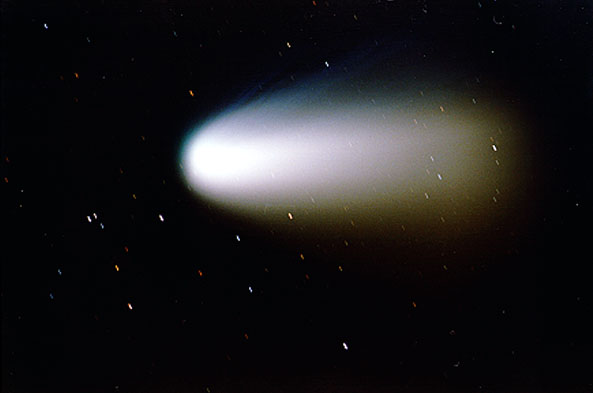COMET C/1995 01 (HALE-BOPP)

|
COMET C/1995 01 (HALE-BOPP) |
|
|
| Processing Data: | Object Info: |
| Negatives - March 1997 | Comet Hale-Bopp (C/1995 01) was visible with the unaided eye from Jul. 1996 thru Oct. 1997, an all-time record, T (time of perihelion)=1997 April 1. During July 1996, 6th magnitude with traces of a tail. Moved westward across Ophiuchus in the evening sky. In mid October, still 5th magnitude but with a 2-3 degree tail. By the end of December, when at solar conjunction, 3rd to 4th magnitude, located in Aquila. Comet reported as magnitude 3.0 in the late January 1997 morning sky with a short tail. During mid February, 2nd magnitude, telescopically displaying extraordinary structures near the nucleus. Two tails of 5 to 10 degrees in length. Comet moved to the northeast across Cygnus in late February, head 1st magnitude. During March, once again passed through solar conjunction but well north of the Sun. Visible at both dawn and dusk for many days, the head zero magnitude at mid month. Nucleus could be followed telescopically until shortly after sunrise. Tails up to 20 degrees long. During early April visible as a striking evening object in northwestern sky crossing Cassiopeia and Perseus, -0.5 magnitude with a strongly curved dust tail at least 25 degrees in length. Toward the conclusion of April, of 1st magnitude when low in the west after twilight. A 2nd magnitude object in Taurus when nearing solar conjunction in mid May. Only visible from the Southern Hemisphere in June, magnitude 2-3 with a short tail. The comet gradually faded as it moved to the southwest: magnitude 3 in July, 4th in August, 5th during September. |
| Meade 5" ED Refractor F/9 | |
| Manual Guiding | |
| Pentax K1000 Body | |
| Kodak PPF 400, Unhypered | |
| 1 x 7 Minute Exposure | |
| Digital Enhanced (levels) in Photoshop | |
| Processing Info: This
is one of many exposures I made during the arrival of Comet Hale-Bopp.
During the period of comet visibility, I acquired the 5" Meade
Refractor and LXD650 mount in lieu of the 90mm refractor and entry level
mount I had been using. I was also beginning to enter the world of Astro-Photography
with the acquisition of the quality mount with PEC. Only issues were
that some pictures made thru the 5" should have been at a much
reduced exposure to try and catch better details in the nucleus, which
were tended to be over exposed on the majority of my collection.
|
|
| Object Details Courtesy "The Bright Comet Chronicles" John E. Bortle, W.R. Brooks Observatory. |